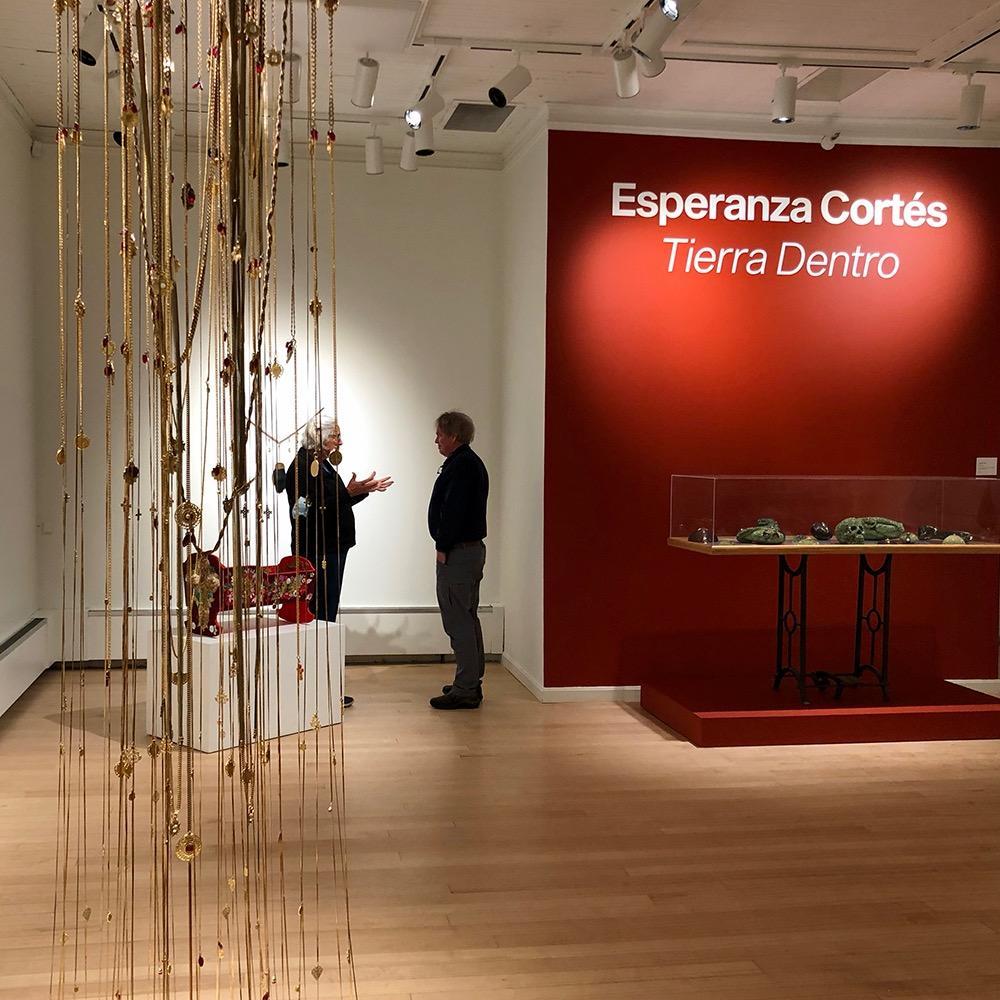Cortés Finds Beauty in Dichotomies of Pre-Colonial Endurance


Esperanza Cortés is an artist whose work could be claimed by any moment in history, traversing universally recognizable materials and subject matter. In tandem with this immediate visual language comes a lexicon both autobiographical and identity-driven, probing the artist’s Colombian roots and creating a bridge between the cultures of Africa and the Americas.
The artist’s current exhibit, Tierra Dentro, was on view until April 8th at The Current in Stowe, VT. Curated by Rachel Moore, this exhibition of work by Cortés presents sculptural and installation-based work as a means of further exploring the rich material cultures that inform Cortés existence, with influences ranging from material culture connected to ancient burial traditions to Afro-Latina dance and ritual.

The artist remarks about her practice, “I make art because I have to.” This compelling force is apparent in how her work drives a transcultural conversation about hybrids converging: a legacy found rooted in her own combined Muisca Indigenous and Afro-Latina heritage. The artist poignantly highlights the conjoined beauty and pain found within these transcultural narratives, in response to the joys of recognizing one’s Indigenous and Afro-Latin roots while having this contrasted to colonial standards of beauty and behavior. This pain is recounted in the visceral reflections of Frantz Fanon who remarked, “the oppressed will always believe the worst about themselves.” Cortés’ work incorporates objects and motifs found across tribal iconography—Ojibwe or Aztec, Baule or Ashanti— while recognizing that in these cultures, various masks and sculpted heads and faces hold significance and beauty unique to the eye of the beholder. Cortés lifts up the relative beauty of these cultures, cementing these forms into contemporary culture while echoing how these cultures persist against continued colonization. Further enlivening this concept, Cortés led workshops over the course of the exhibition where she guided participants in their own personal myth-making through artistically resonant imagery.


The exhibition incorporates texture and materiality in careful approaches to form. In works such as “Second Sight”—when contrasted with “Cumbia,” titled after an Afro-Latin dance form—have apparent similarities yet strongly diverge. Where “Second Sight” offers enmeshed glass and metal elements into sculptures appearing as skull artifacts, “Cumbia” presents a sensuous face composed of clay and is embellished with emerald shell chips. While both sculptures depict human heads, each takes separate space as a combination of artwork and ritual artifact. Cortés shows her perceptive approach as an artist in her use of iconography. She blends a deft combination of technical proficiency in “Cumbia” with a sense of intimacy, with the upturned head combined with precious materials resting in an evocative and vulnerable pose. This sense of relative ease and comfort forms a clear juxtaposition to the ever-present legacy of colonization—referred to in the exhibition materials as a process of “plunder, pillage and violence dressed as civilization.” These contrasts of beauty and pain, violence and peace form the crux of the artist’s approach to continuing to form a wider net of connections across communities that have experienced these dichotomies.
Cortés’ practice also embraces visceral design patterns and materials, such as wood and stone, that form a dialogue with visuals that have persisted through the ages from ancient civilizations into the present day. The exhibition takes its title from Tierradentro a national archaeological park in Colombia home to possibly the largest cluster of ancient burial sites in Latin America. The cave tombs present throughout the site are intricate and ornate. Visual elements present throughout the tombs are striking and incorporate universal motifs such as circular designs, triangles, and geometric patterns—the oldest are nearly 1,400 years old. Works on view in Tierra Dentro transcend one particular moment in time, seemingly comfortable in any era, as a record of material culture.

The exhibition combines concrete visual elements with materials and patterning specific to transcultural experiences of communities persisting through colonization, reflecting Cortés’ own personal legacy in dialogue with her experience with Afro-Latin visual and performing art traditions. Her past work as a dance teacher instructing in merengue, samba, and cumbia has played a role in how she approaches composition-making. By drawing from these experiences while incorporating interior elements and furniture, such as chairs, and minerals and gemstones specific to the mining industry in South America, the artist recalls the continued presence of Colonialism’s enduring impact in the region.
Though death and pain have held a firm space in the consciousness of generations of colonized communities, the artist is not forming an elegy in this exhibition inasmuch as she celebrates resistance and the continued generational presence of Indigenous communities and traditions despite all odds. Her works hold space for bodies, implied or explicit, and combine lush riches and vitality. Tierra Dentro marks a powerful exhibition evoking cultural memory, the continued resilience against colonial structures in society, and the enduring presence of folk traditions generation after generation.
Tierra Dentro was on view at The Current in Stowe, VT from January 26 through April 8, 2023.
You Might Also Like
The Immigrant Artist Biennial Offers a Lesson in Perseverance
How Proxyco Gallery is Changing the Face of Latin American Art in New York
What's Your Reaction?
Audra Verona Lambert is a writer and curator based in Brooklyn, NY, raised in Terrebonne Parish, Louisiana, USA. Lambert holds an MA, Art History and Visual Culture from Lindenwood University. Her writing has been featured in The Culture Trip, HuffPost Arts & Culture, Portray Mag, Fine Art Globe, Quiet Lunch and others. Her curatorial projects have been featured at the Yeshiva University Museum, FORMah Gallery, EFA Project Space and more. She has written on art topics and curated exhibits for over eleven years in and around New York City.

